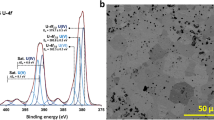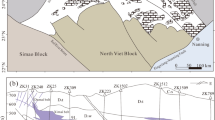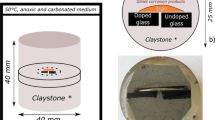Abstract
SOME of the Precambrian natural fission reactors at Oklo in Gabon contain abundant organic matter1,2, part of which was liquefied at the time of criticality and subsequently converted to a graphitic solid3,4. The liquid organic matter helps to reduce U(VI) to U(IV) from aqueous solutions, resulting in the precipitation of uraninite5. It is known that in the prevailing reactor environments, precipitated uraninite grains incorporated fission products. We report here observations which show that these uraninite crystals were held immobile within the resolidified, graphitic bitumen. Unlike water-soluble (humic) organic matter, the graphitic bituminous organics at Oklo thus enhanced radionu-clide containment. Uraninite encased in solid graphitic matter in the organic-rich reactor zones lost virtually no fissiogenic lan-thanide isotopes. The first major episode of uranium and lead migration was caused by the intrusion of a swarm of adjacent dolerite dykes about 1,100 Myr after the reactors went critical. Our results from Oklo imply that the use of organic, hydrophobic solids such as graphitic bitumen as a means of immobilizing radionuclides in pretreated nuclear waste warrants further investigation.
This is a preview of subscription content, access via your institution
Access options
Subscribe to this journal
Receive 51 print issues and online access
$199.00 per year
only $3.90 per issue
Buy this article
- Purchase on Springer Link
- Instant access to full article PDF
Prices may be subject to local taxes which are calculated during checkout
Similar content being viewed by others
References
Geoffroy, J. The Oklo Phenomenon, 133–149 (IAEA, Vienna, 1975).
Alpern, B. Natural Fission Reactors, 333–351 (IAEA, Vienna, 1978).
Leventhal, J. S., Nagy, B. & Gauthier-Lafaye, F. US Geol. Surv. Open-File Rep. 89–668, 1–18 (1989).
Cortial, F., Gauthier-Lafaye, F., Lacrampe-Couloume, G., Oberlin, A. & Weber, F. Org. Geochem. 15, 73–85 (1990).
Choppin, G. R. & Rydberg, J. Nuclear Chemistry: Theory and Applications, 235 (Pergamon, Oxford, 1980).
Naudet, R. Oklo: des Réacteurs Nucléaires Fossiles, 695 (ed. le Commisariat à I'Energie Atomique, Paris, 1991).
Gauthier-Lafaye, F., Weber, F. & Ohmoto, H. Econ. Geol. 84, 2286–2295 (1989).
Gauthier-Lafaye, F. & Weber, F. Econ. Geol. 84, 2267–2285 (1989).
Holliger, P. & Devillers, C. Earth planet. Sci. Lett. 52, 76–84 (1981).
Bros, R., Gauthier-Lafaye, F., Stille, P. & Clauer, N. Symp. Metalliferous Black Shales and Related Ore Deposits, IGCP Proj. 254, Abstr. 1 (1990).
Bostick, N. H., Aspects of Diagenesis Soc. Econ. Palaeont. Mineral. Spec. Publ. 25 (eds Sholle, P. & Schluger, P. R.) 17–43 (1979).
Nagy, B. & Mossman, D. J. Early Organic Evolution: Implications for Mineral and Energy Resources (ed. Schidlowski, M.) 224–231 (Springer, Heidelberg, in the press).
Lewan, M. D., Winters, J. C. & McDonald, J. H. Science 203, 897–899 (1979).
Nagy, B., Leventhal, J. S. & Gauthier-Lafaye, F. US Geol. Surv. Circ. 1058, 65–67 (1991).
Leventhal, J. S. & Hofstra, A. H. US Geol. Surv. Circ. 1035, 42 (1988).
Choppin, G. R. Radiochim. Acta 44/45, 23–28 (1988).
Nagy, B., Thurman, E. M., Long, A. & Hare, P. E. GSA Abstr. with Programs, A173 (GSA, Boulder, 1988).
Loss, R. D. et al. Chem. Geol. 76, 71–84 (1989).
Curtis, D. et al. Appl. Geochem. 4, 49–62 (1989).
Loss, R. D. et al. Earth planet. Sci. Lett. 89, 193–206 (1988).
Neuilly, M., Dozol, J. F. & Naudet, R. Natural Fission Reactors, 433–440 (IAEA, Vienna, 1978).
Ludwig, K. R., Nash, J. T. & Naeser, C. W. Econ. Geol. 76, 89–110 (1981).
Holliger, P., Pagel, M. & Pironon, J. Chem. Geol. 80, 45–53 (1989).
Bonhomme, M., Gauthier-Lafaye, F. & Weber, F. Precambrian Res. 18, 87–102 (1982).
Holliger, P. C. R. Acad. Sci. Paris 307, II, 367–373 (1988).
Ruffenach, J. C., Menes, J., Devillers, C., Lucas, M. & Hagemann, R. Earth planet. Sci. Lett. 30, 94–104 (1976).
Ludwig, K. R., Earth planet. Sci. Lett. 46, 212–220 (1980).
Loss, R. thesis, Univ. of Western Australia (1986).
Author information
Authors and Affiliations
Rights and permissions
About this article
Cite this article
Nagy, B., Gauthier-Lafaye, F., Holliger, P. et al. Organic matter and containment of uranium and fissiogenic isotopes at the Oklo natural reactors. Nature 354, 472–475 (1991). https://doi.org/10.1038/354472a0
Received:
Accepted:
Issue Date:
DOI: https://doi.org/10.1038/354472a0
This article is cited by
-
Temperature oscillations near natural nuclear reactor cores and the potential for prebiotic oligomer synthesis
Origins of Life and Evolution of Biospheres (2016)
-
The removal of uranium onto carbon-supported nanoscale zero-valent iron particles
Journal of Nanoparticle Research (2014)
-
Isotopic study of natural fission reactors at Oklo and Bangombé, Gabon
Journal of Radioanalytical and Nuclear Chemistry (1999)
-
In situ examination of uranium contaminated soil particles by micro-X-ray absorption and micro-fluorescence spectroscopies
Journal of Radioanalytical and Nuclear Chemistry (1998)
-
Single-crystal trace element analysis in rock-forming minerals by instrumental neutron activation analysis
Journal of Radioanalytical and Nuclear Chemistry (1997)
Comments
By submitting a comment you agree to abide by our Terms and Community Guidelines. If you find something abusive or that does not comply with our terms or guidelines please flag it as inappropriate.



